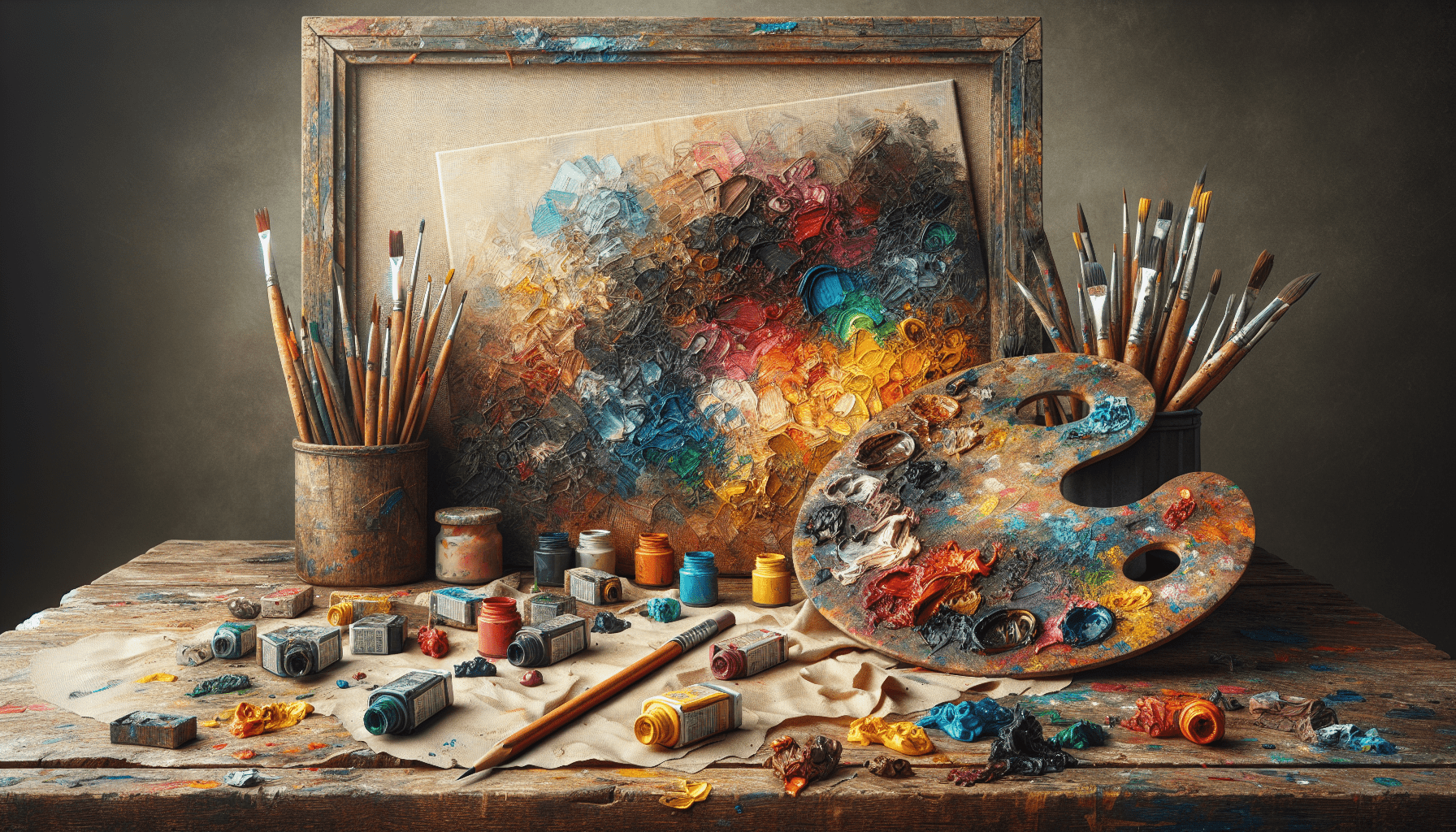What inspires you to pick up a paintbrush or a pencil for the first time? Whether it’s a newfound passion or a desire to express your thoughts visually, starting your art journey can be exciting yet overwhelming. Below are some essential art tips designed to help beginners like you navigate the vibrant world of creativity.
Understanding the Fundamentals of Art
Creating art is much like building a house; a solid foundation is crucial. Understanding the basic principles of art can help you express your ideas more effectively and enjoy the process.
The Elements of Art
Familiarizing yourself with the fundamental elements of art will enhance your skills and enrich your creations. Here’s a quick breakdown:
| Element | Description |
|---|---|
| Line | A mark connecting two points; it can be curved, straight, thick, or thin. |
| Shape | A flat area defined by boundaries; shapes can be geometric (like squares) or organic (like leaves). |
| Form | Three-dimensional shapes; forms have volume and take up space. |
| Color | The attribute of an object that is produced by the way it reflects or emits light. Color can evoke emotions and set moods. |
| Value | The lightness or darkness of a color; it adds depth and dimension. |
| Texture | The surface quality of an object; it can be smooth, rough, soft, or hard. |
| Space | The area around, above, below, or within an object; it can create a sense of depth. |
Understanding these elements will allow you to experiment and combine them in your own unique ways.
Principles of Design
In addition to the elements of art, grasping the principles of design will enhance your compositions. Here’s how they can be categorized:
| Principle | Description |
|---|---|
| Balance | The distribution of visual weight; it can be symmetrical or asymmetrical. |
| Contrast | The juxtaposition of opposing elements (like light and dark) to create interest. |
| Emphasis | Drawing attention to a focal point in your artwork. |
| Movement | The path the viewer’s eye takes through the artwork; use lines and shapes to guide them. |
| Pattern | The repetition of elements to create structure or decoration. |
| Rhythm | A visual tempo created through the arrangement of elements. |
| Unity | The harmony achieved when all parts of a piece come together cohesively. |
These principles help you arrange the elements of art effectively, resulting in compelling visuals.
Finding Your Medium
Art encompasses a wide range of mediums, from traditional painting to digital forms. Exploring various mediums can be a fun experiment, and you might find one that truly resonates with you.
Painting
If you enjoy color, painting can be a great outlet for your creativity. You can choose from various types like acrylic, oil, or watercolor. Each medium has unique characteristics:
- Acrylic: Dries quickly and is versatile; great for layering.
- Oil: Offers rich colors and is slow-drying, allowing for blending.
- Watercolor: Known for transparency and fluidity, it can create soft washes.
Drawing
Drawing is a direct and accessible form of art. You could opt for pencil, charcoal, ink, or pastels. Each tool offers a different technique and style:
- Pencil: Offers control and precision; ideal for detailed work.
- Charcoal: Provides strong contrast and rich blacks; excellent for expressive styles.
- Ink: Great for bold lines and intricate details; requires some practice to master.
Mixed Media
For those who want to push creative boundaries, mixed media combines different materials like paint, collage, and found objects. This approach encourages experimentation and can lead to surprising results.
Building Your Art Skills
Now that you have some understanding of the fundamentals and mediums, it’s time to work on improving your skills. With practice and the right techniques, you’ll find your style developing beautifully.
Practice Regularly
Consistency is key when it comes to honing your art skills. Make it a habit to set aside time every week to create. Whether it’s daily sketches or a weekly painting session, regular practice will lead to improvement.
Study from Life
Observational skills are an essential part of being an artist. Drawing or painting from real-life subjects helps train your eye to notice details and proportions. Try sketching objects in your environment, or explore life drawing classes if you’re feeling adventurous.
Embrace Mistakes
Don’t let the fear of making mistakes hold you back. Every artist has experienced failures, but they often lead to the most valuable learning opportunities. Embrace your errors and see them as stepping stones on your artistic journey.
Finding Inspiration
Inspiration can come from countless sources, but it’s crucial to keep your creative well full. Being inspired will help you generate new ideas and projects.
Nature
The natural world offers a wealth of inspiration, from landscapes to intricate details in flowers and leaves. Taking walks or exploring parks can ignite your imagination and lead you to new artistic ideas.
Local Art Community
Get involved in your local art community. Attend gallery openings, workshops, or art fairs where you can meet fellow artists and observe their techniques. Engaging with others can spark inspiration and motivate you to continue creating.
Online Resources
The internet is teeming with resources for artists. Websites, forums, and social media platforms can provide inspiration and connect you with art communities around the world. Look for tutorials, challenges, or prompts that encourage you to try something new.
Developing Your Style
As a beginner, it’s essential to experiment with various techniques and styles to discover what resonates with you. Your unique voice will evolve over time.
Experimentation
Feel free to try new approaches, whether it involves using different tools, working with new subjects, or combining mediums. Through experimentation, you’ll learn what you enjoy most and what best expresses your artistic vision.
Study Other Artists
Study the works of artists you admire. Analyze their techniques, color palettes, and compositions. This doesn’t mean copying their work, but rather understanding their approach and finding inspiration to develop your distinct style.
Create a Body of Work
Start assembling a collection of your art. Over time, patterns in your interests and techniques will emerge, which can guide you in refining your style. Don’t hesitate to revisit and rework older pieces; this can be a great way to track your growth as an artist.
Building a Portfolio
Once you’ve started creating a body of work, you might think about assembling a portfolio. A portfolio showcases your best pieces and reflects your artistic journey.
Choosing Your Best Work
Select pieces that represent your style and growth. Aim for a diverse range that demonstrates your skills in different mediums and techniques. Quality over quantity is key—choose works that you feel confident about.
Presentation Matters
How you present your portfolio can make a significant impression. Consider the layout, background, and format. Whether digital or physical, ensure it’s clean and well-organized, allowing the artwork to stand out without distraction.
Keeping It Updated
Your portfolio is a living document that should evolve as you grow as an artist. Regularly update it with new work, and be willing to remove older pieces that no longer represent your best abilities.
Sharing Your Work
As an artist, sharing your work can be just as important as creating it. Whether through social media or exhibitions, showcasing your art allows you to connect with others and gather feedback.
Social Media
Platforms like Instagram, Facebook, and Pinterest are excellent for artists to share their work and connect with a wider audience. Post consistently, and use relevant hashtags to reach people interested in your art style.
Local Exhibits and Open Studios
Participating in local art shows or open studio events is a fantastic way to gain exposure. These events allow you to engage directly with audiences and receive constructive feedback while building your local community connections.
Personal Website
Consider creating your own website to showcase your portfolio professionally. This allows potential buyers and art enthusiasts to find your work easily. Include a blog section where you can share your experiences, thoughts on various art techniques, and updates about your projects.
Learning and Growing
The journey of an artist is continuous, and there’s always something new to learn. Embrace this learning process.
Take Classes
Enrolling in art classes can greatly enhance your skills. Whether you choose online courses or local workshops, structured lessons provide guidance and insight that can be hard to find alone.
Seek Feedback
Don’t shy away from asking for constructive criticism. Feedback from peers or mentors can provide valuable insights that may not be apparent to you. Use this information to strengthen your skills and improve future works.
Read Art Books and Resources
There are countless books and online resources available that focus on art techniques, history, and theory. Reading not only enhances your knowledge but can also spark creativity and new ideas to implement in your own art.
Conclusion
Starting your artistic journey can be both thrilling and daunting, but remember that every artist has been a beginner at some point. Embrace the learning process, be patient with yourself, and enjoy every moment of creating. With time, practice, and a willingness to experiment, you’ll uncover your unique voice and find joy in your art. So, what’s your next masterpiece going to be?


Leave a Reply